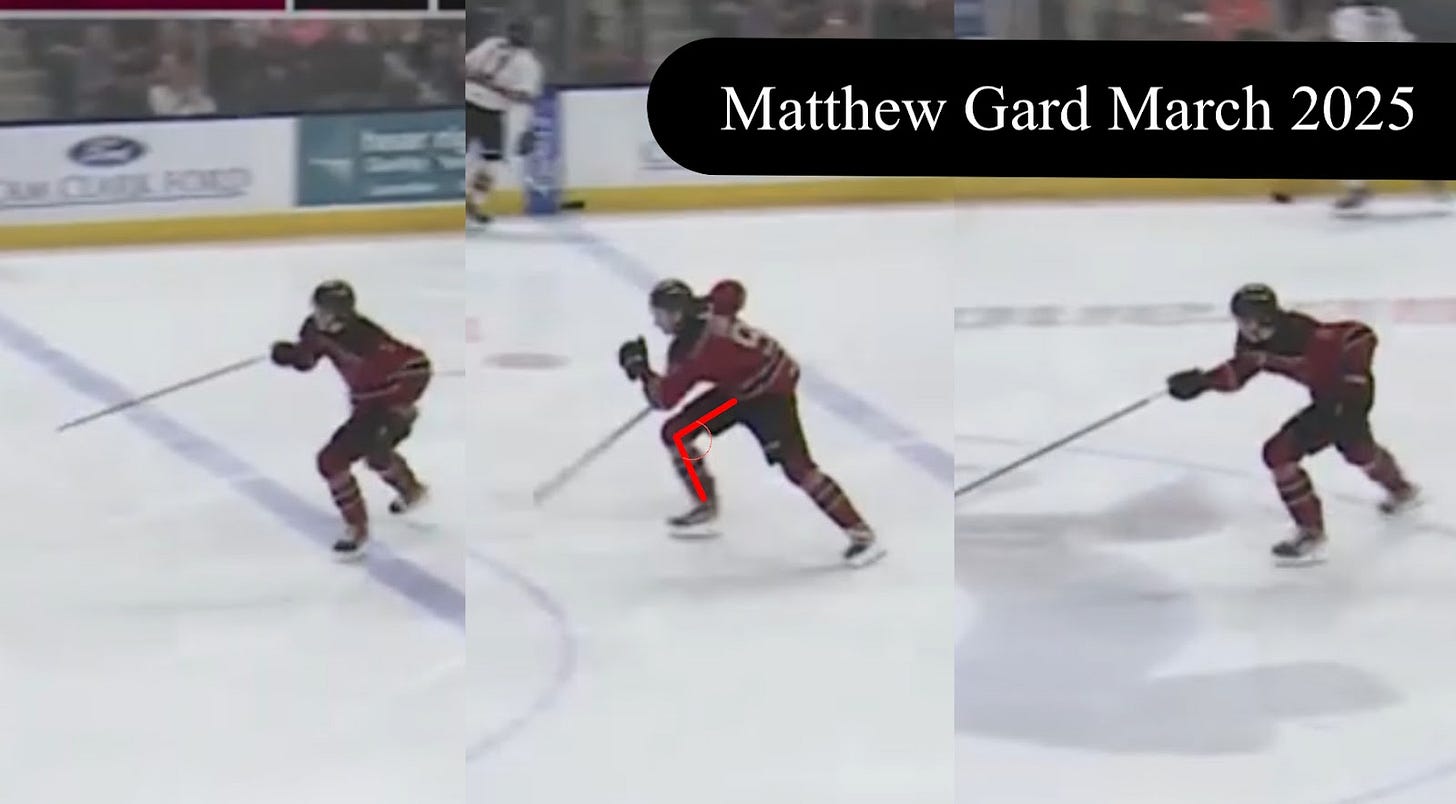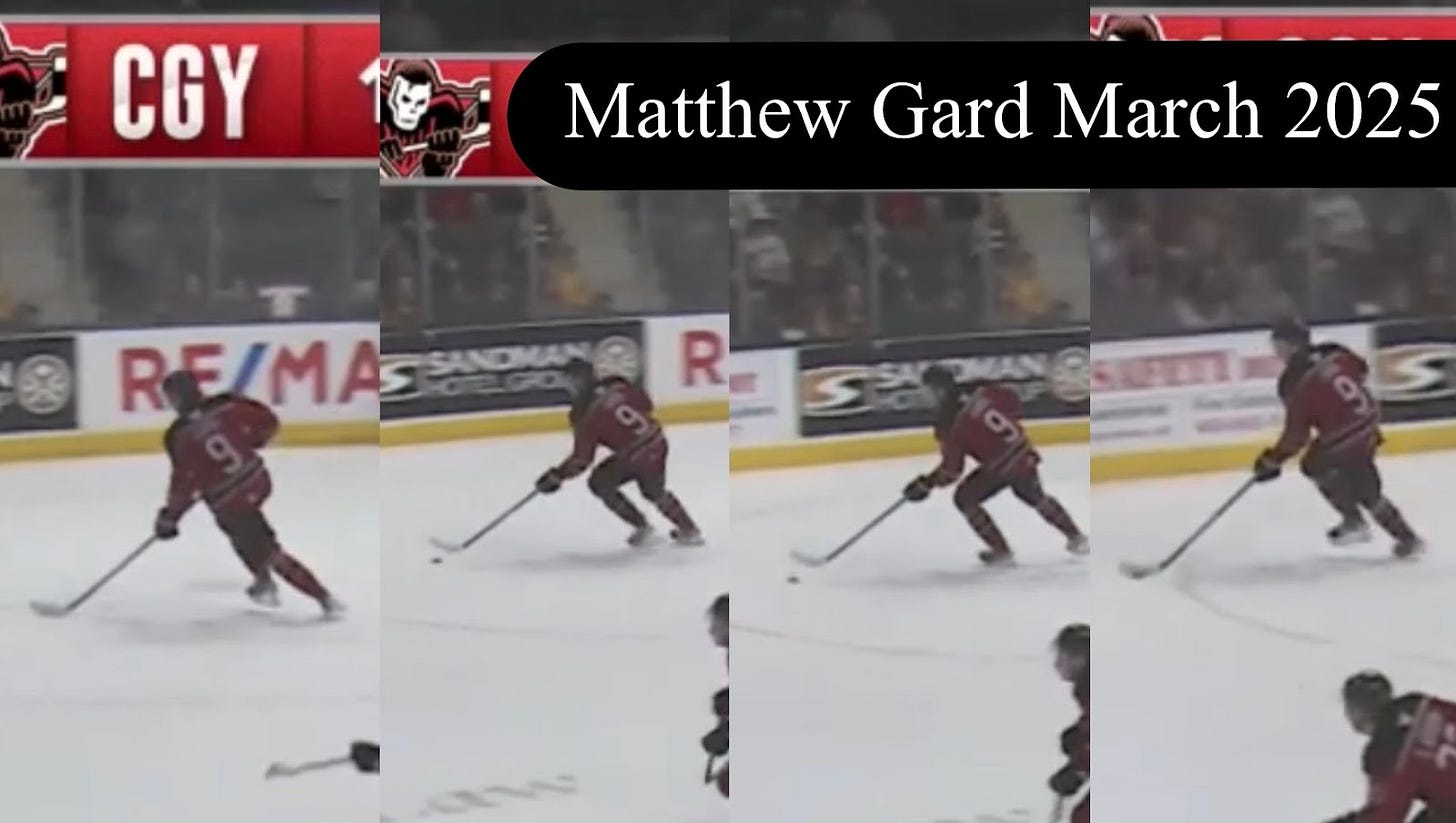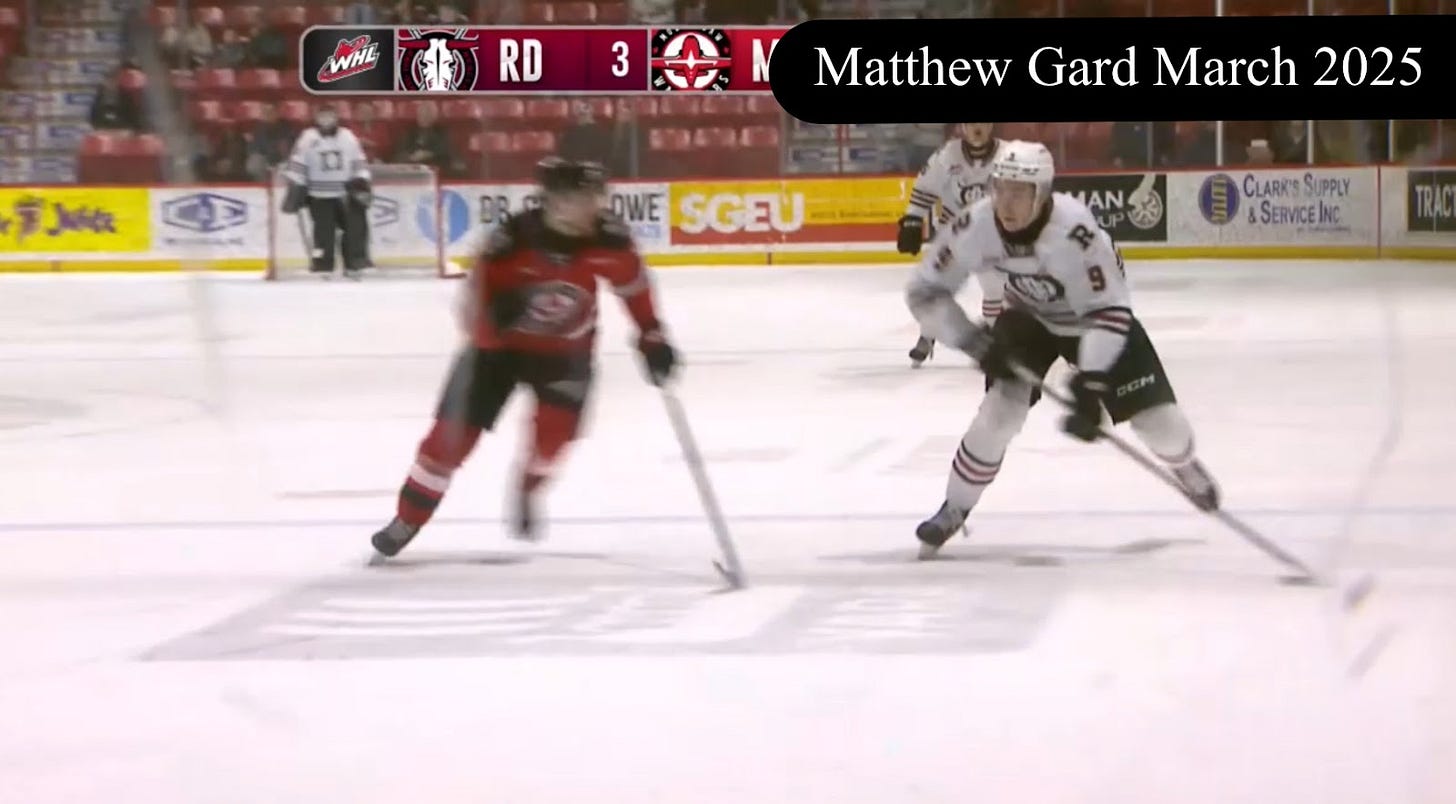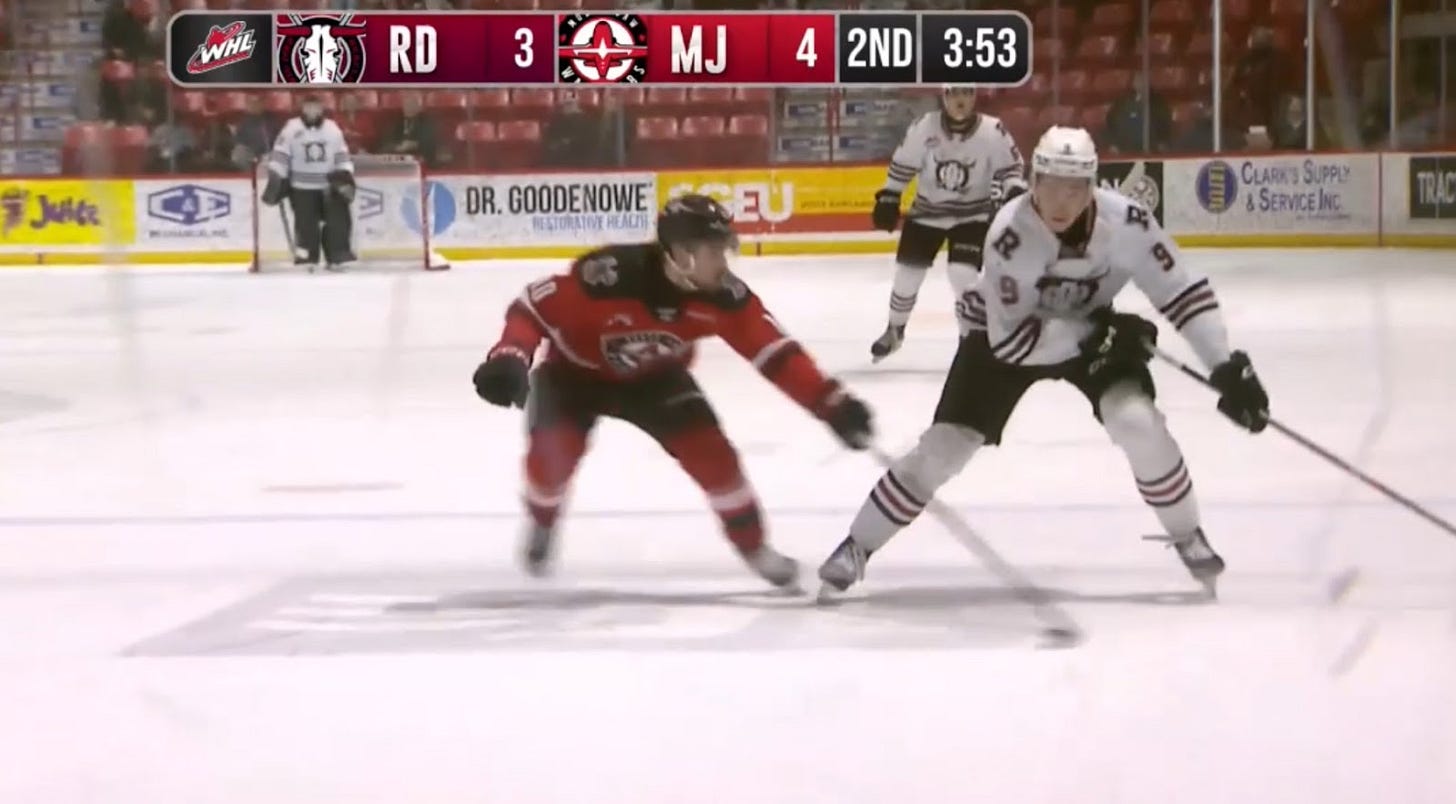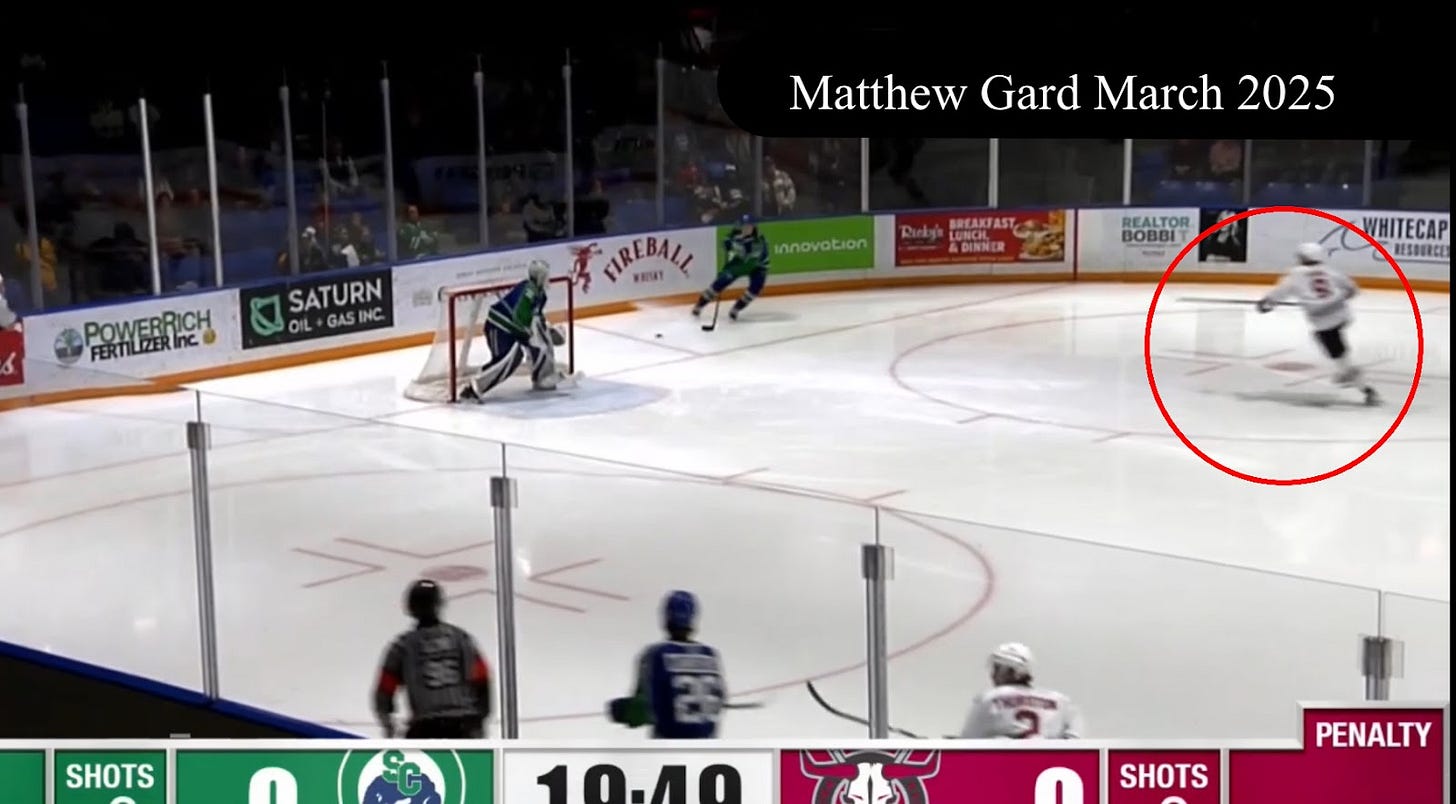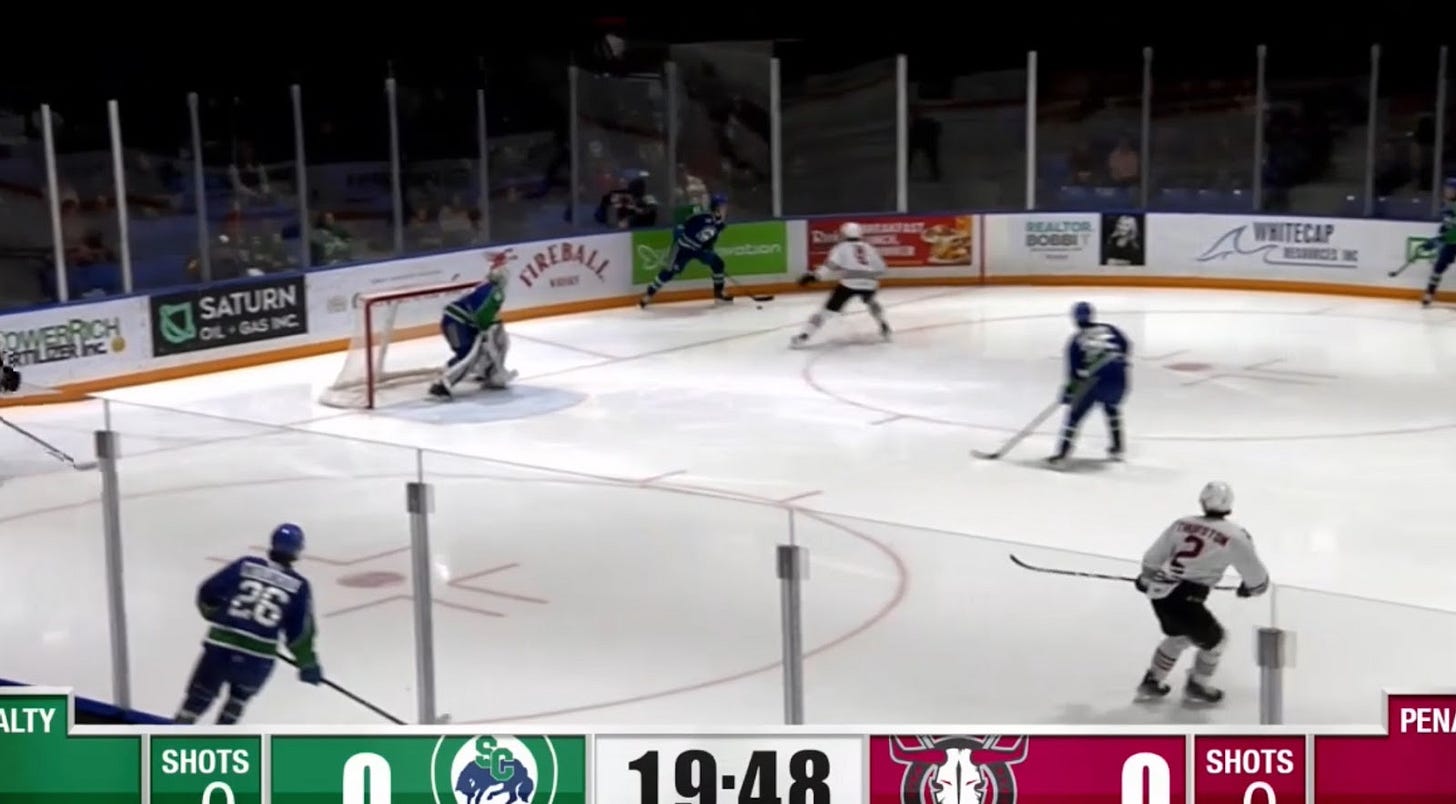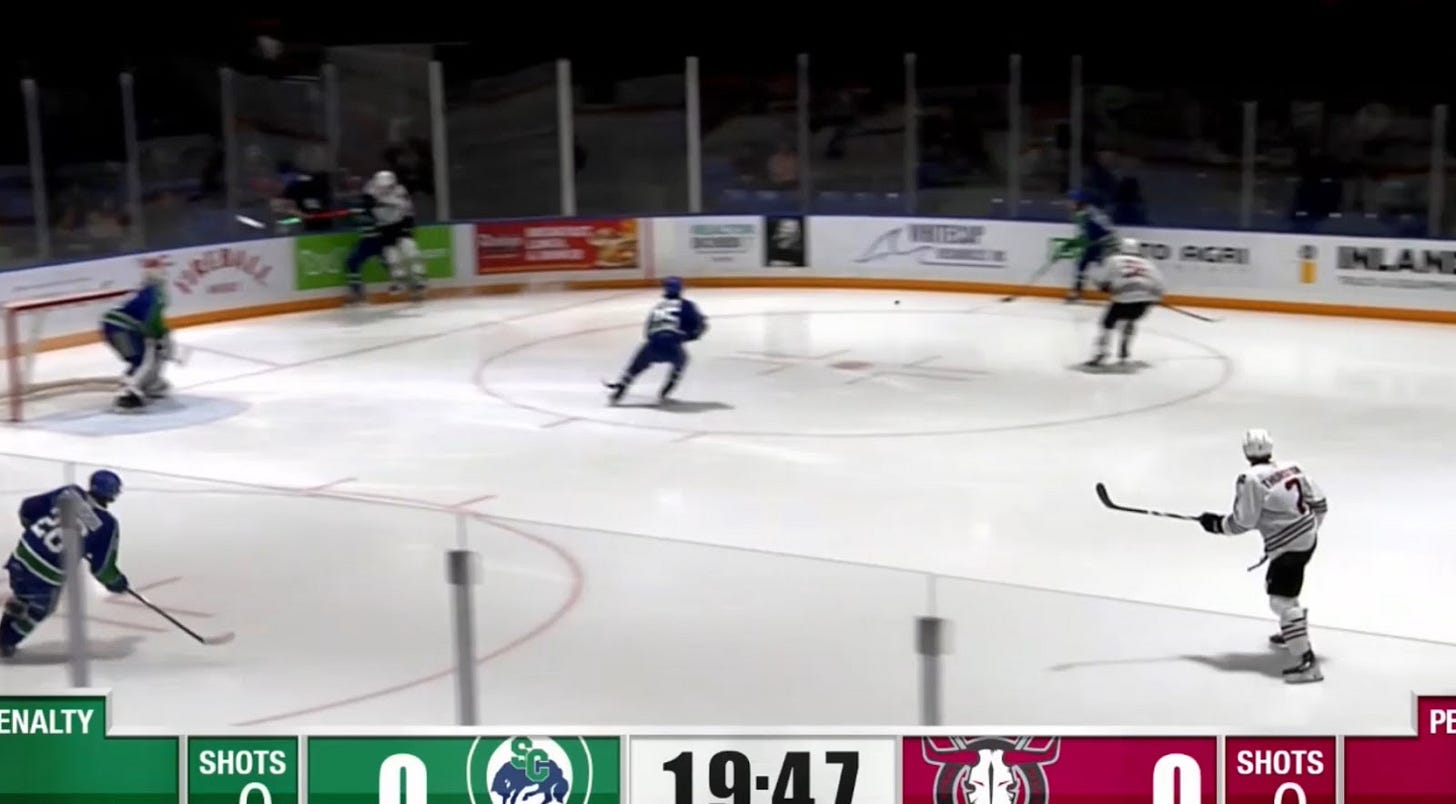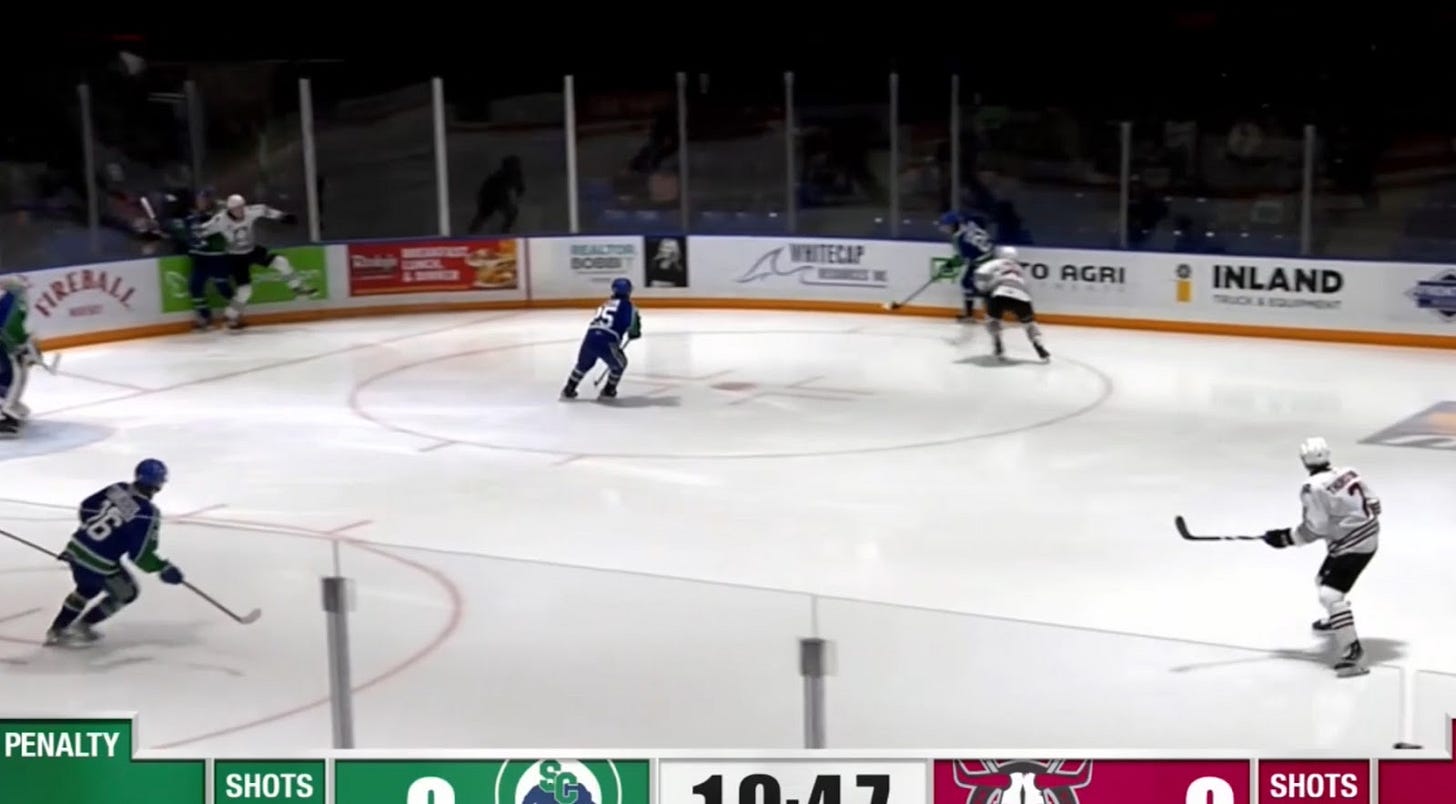Skating:
- Straight Line Skating:
Matthew Gard plays the game at a slow pace and doesn’t showcase his top speed often, in today’s game this likely affects his overall projection, but once he gets going his straight line skating is actually pretty good, getting a lot out of the power of his frame. His stride mechanics are not that bad, but not perfect by any means. His first step acceleration is poor. He is far too upright in this facet, and could use more knee bend. When looking at his stride phase however, his knee bend is good, very close to 90 degrees and enough to keep his knees over his toes and keep his shin and back angle parallel. He actually tilts his upper body forward somewhat well in his stride phase. His stride recovery is under the midline of his body allowing for full back leg extension, which he gets very close to, maximising power output. He has a strong foundation to build off of, but his acceleration is something I would really focus on in his development. Lastly, a criticism I have of Gard is that there could be ankle flexion issues which could help explain why it is difficult for him to accelerate quickly or transition efficiently through directional changes.
Gard had a manually tracked top speed in the 48th percentile of all players I have tracked in my 4 year dataset in the 3 WHL games I tracked of him this season. I should mention that my dataset may be a skewed sample due to my tendency to want to track faster players. With that being said though, Gard needs to improve his acceleration if he really wants to improve the pace of his game.
Lateral Skating:
Moving laterally, Gard has many of the same strengths and weaknesses as moving in a straight line. His skating mechanics showcase some positive attributes that compensate at times for his lack of explosiveness. The foundation of Gard's lateral movement lies in his strong edgework and crossover technique. He demonstrates impressive lower-body flexion for a player of his stature, allowing him to maintain solid balance through turns and directional changes. His ability to dig into his edges gives him solid power generation when maneuvering along the boards or through traffic. His edge control proves particularly valuable in puck protection situations, where he uses subtle lateral adjustments to shield possession from defenders.
Gard's crossovers show promising elements of efficiency. He maintains reasonably tight turning radii and demonstrates the capacity to link multiple crossovers together when building speed east-west. His transitions from forward to backward skating incorporate effective weight transfer, though there's room for improvement in the fluidity of these movements. The mechanical base exists for him to develop into a more explosive lateral skater with targeted training. However, several technical limitations currently cap Gard's lateral agility. His inside-edge pushes lack the explosive quality needed to create immediate separation from defenders. While his crossovers are technically sound, they don't yet generate the sudden bursts of speed that characterize elite skaters at the professional level. His foot recovery between strides shows a slight delay that interrupts momentum, particularly when changing directions under pressure. His posture during lateral movements presents another area for development. While he generally maintains good knee bend, he occasionally rises up through transitions, causing his center of gravity to shift too high. This postural inconsistency can lead to balance issues when executing quick changes of direction against tight-checking opponents. Refining his ability to stay low and powerful through complete crossover sequences would enhance his stability and power output.
Gard's lateral mobility serves him well in several game situations. He shows competence working the half-wall on the power play, using controlled crossovers to create passing lanes and shooting angles. His edgework allows him to extend offensive zone possessions along the boards, where he can pivot away from pressure or spin off checks to maintain puck control. Defensively, his lateral movement enables him to stay with opponents when tracking back, though improving his first-step quickness would make him more effective against speedy attackers. His skating also shows particular promise in board battles and net-front situations. His ability to make micro-adjustments using inside edges helps him establish and maintain positioning in high-traffic areas. This skill translates well to his net-front presence, where subtle lateral shifts allow him to find soft ice and create deflection opportunities.
Looking ahead, Gard's lateral skating development should focus on three key areas, increasing the power of his inside-edge pushes to generate more explosive directional changes, improving foot quickness to reduce recovery time between crossovers, and maintaining consistent knee bend through complete movement sequences. Addressing these elements would help him overcome some of the mobility challenges typically associated with players of his size.
Skills:
Size and Reach
Standing at an imposing 6'4.5", Matthew Gard possesses game breaking size. His frame alone gives him inherent advantages, but what is more exciting is how much room he still has to grow into his game. Gard’s size translates most obviously to net-front dominance, where he uses his body to shield defenders, win positioning battles, and create havoc in high-traffic areas. His ability to spin off checks and move the puck with heavy back pressure, is notable and he has an arsenal of net-front tricks and a knack for sneaking under coverage for deflections. This is crucial in today’s NHL, where size around the crease can tilt power plays and create second-chance opportunities. His reach also makes him a disruptive defensive presence, whether it’s breaking up passes or tying up opponents in board battles.
Yet, while Gard’s physical tools are evident, he’s still learning to maximize them. He ranks between the 20th-50th percentile among WHL forwards in microstats that can be indicators of size and strength made advantages, metrics like average time per puck touch, puck battle win rate, and penalties drawn. For a player of his stature, those numbers hint at untapped potential. He could use his body more to create additional space and he has more room to physically dominate. This disconnect, between his obvious physical gifts and his still-developing ability to impose himself consistently suggests that Gard’s best hockey may still be ahead of him. If he can refine his puck protection, and this starts with mechanics. He can begin to leverage his size more assertively in battles, and create longer stretches of meaningful possession for himself and his team.
Gard possesses all the physical tools to excel at puck protection, and he uses them effectively. His game revolves around intelligent body positioning and an understanding of how to leverage his frame to maintain possession under pressure. He is strong on his skates and has the balance to allow him to pivot away from defenders while keeping the puck out of reach. He does well at using subtle lateral movements to shield the puck, adjusting his body angle to cut off opposing players without sacrificing his ability to make a play. His wide stance and low center of gravity make him difficult to knock off the puck, even when facing heavy pressure along the boards. His reach is another major asset in protection situations. Gard keeps the puck extended away from his body, forcing defenders to overcommit if they want to challenge him directly. This creates separation and opens up passing lanes that might not otherwise be available. When pressured, he demonstrates good enough hands to make quick adjustments, whether it's a subtle toe drag or a last-second pull to avoid a stick check. While he's not the type to attempt highlight-reel dekes, his puckhandling is efficient and purposeful in tight spaces. One area where Gard could improve is in adding more deception to his protection game. Incorporating fake spins or shoulder feints would make him even harder to read in one-on-one battles. Developing stronger one-handed control would also allow him to maximize his reach advantage, particularly when fending off defenders while driving wide. Additionally, improving his first-step acceleration out of protection plays would help him transition more quickly from puck possession to offensive creation.
Playmaking
Gard has an underrated playmaking touch, especially considering his assist total this season that could elevate his NHL projection. While he may never be a pure offensive catalyst, his ability to create chances, particularly at even strength, suggests there’s more skill here than meets the eye. Gard’s playmaking stands out in subtle but effective ways. He thrives in quick-strike situations, using his size to protect the puck just long enough to make smart, decisive passes. His spin-around backhand pass into the slot to create a high danger opportunity is something he does often. His ability to find non-obvious targets in transition with quick passes across the ice give him some value in his area despite his lack of pace in his game. These flashes reveal a player who processes the game well and understands how to manipulate defenders. His 64th-percentile ranking among WHL forwards in even-strength shot assists per 60 (min. 15 GP, per Instat) backs this up, he’s quietly above average at setting up teammates. What makes Gard’s playmaking intriguing is how it meshes with his physical tools. At 6’4.5", he can shield the puck under pressure, drawing defenders in before slipping passes to open teammates. He has a wide arsenal of subtle skills that includes a slick backhander that he can deliver in motion and his look-offs to create space for teammates. His 71st-percentile ranking in EV high danger passes per 60 (min 15 games per Instat) further shows that he has the vision to exploit seams when given the opportunity.
That said, Gard’s playmaking isn’t without limitations. His rush creativity is inconsistent, and he can default to simple chips or perimeter plays when pressured. But his playmaking mind is hidden by his environment, with better linemates or more offensive trust, his assist numbers could climb. For a player often pigeonholed, these glimpses of playmaking upside hint at a higher ceiling. If he can refine his decision-making and assert himself more consistently as a passer, Gard could evolve into a player who chips in secondary offense, a valuable commodity in today’s NHL.
Forechecking
Matthew Gard's forechecking game presents a case study in how a big, physically dominant forward is so valuable in forechecking, even with poor acceleration. While his lack of elite top-end speed would typically limit a forechecker's effectiveness in today's fast-paced game, Gard has developed a physical approach that allows him to be highly disruptive despite this limitation. How effective this will be at higher levels is yet to be seen. His 70th-percentile hit rate among WHL skaters is impressive but the foundation of Gard's forechecking success lies in his hockey IQ and understanding of angles. Unlike faster forecheckers who can rely on explosive acceleration to close gaps, Gard employs an approach that accounts for his skating limitations. His ability to angle attackers and match their work, demonstrate how he uses smart positioning rather than pure speed to be effective. His long reach becomes a particularly valuable asset, allowing him to disrupt plays even when he can't quite close that final gap, poking pucks loose or deflecting passes with well-timed stick checks.
Gard's massive 6 '4.5 " frame serves as the great equalizer in his forechecking game. When he can't beat defenders with speed, he uses his body to seal them off along the boards, leveraging his strength to win battles even when arriving a half-step late. His rank in the 34th percentile among WHL forwards in puck battle win rate will improve and when this happens his game will become noticeably more effective. His physical presence forces opponents into rushed decisions, often resulting in turnovers even before contact is made. This ability to impact plays without always needing to make the big hit is what makes his forechecking so effective despite not being the fastest skater on the ice. However, the lack of elite speed does create some clear limitations in Gard's game. In recovery situations, when he occasionally overcommits, he lacks the footspeed to quickly get back into the play. He's also less effective against quick-up transitions where pure speed is at a premium, and his aforementioned puck battle win rate may partially stem from arriving just a fraction late to some loose pucks. These limitations suggest that while Gard can be highly effective in structured forechecking systems, he may need to be deployed strategically to maximize his strengths.
The path forward for Gard's development lies in further refining his already impressive hockey sense and positioning. By improving his first three strides to maximize his acceleration window and developing even quicker stick reads to initiate disruptions earlier in sequences, and his stick work in tight during battles, he can continue to mitigate his speed limitations. His game serves as a reminder of how big, physically dominant forwards can adapt to the modern game's speed demands through intelligence and effort. While he may never be the fastest forechecker, Gard's combination of size, anticipation and relentless motor gives him tools to be an effective disruptor at higher levels.
Defensive Impact
Much like his forechecking, Matthew Gard's defensive game is built on disruption. It starts with Gard's stick work and positioning. He clamps sticks, roughs up perimeter activators, and pushes aggressive pressure through his reach advantages. This ability to disrupt plays without taking himself out of position helps explain his strong takeaway numbers (78th-percentile ranking in takeaways per 60 and an 83rd-percentile mark in defensive-zone takeaways per 60). His long reach allows him to break up passes and lift sticks consistently. He's all over puck carriers in his own end and has shown the ability to angle attackers well. His anticipation skills are also strong and he has many games where he catches opponents off-guard with well timed pokes and stick lifts.
What makes Gard's defensive metrics even more impressive is his heavy deployment. As his team's most utilized forward in defensive situations, he faced tough matchups nightly yet still managed strong suppression numbers. His ranking of 14/30 among teammates in expected goals against per minute while playing on defence (playing in DZ without possession) despite playing against the other teams top players speaks to his ability to limit quality chances against. His support-first mentality and his tendency to consistently work to get above the puck are keys to maintain this despite his skating. Gard's physicality adds another layer to his defensive game. He uses his frame to tie up threats, take them into the wall, and attach himself to opponents' hips to control their movements. Projected to the NHL, Gard's defensive toolkit, particularly his stick work, physicality, and anticipation skills, gives him possible value as a bottom-six center who can handle tough matchups. With improved footspeed, he could develop into a player who can handle tougher matchups and a true physical presence. For now, he's on pace to be one of the WHL's most complete defensive forwards, using his size and smarts to drive results despite heavy defensive workload.
Perception:
Tactical Recognitions
The Red Deer Rebels endured a difficult 2023-24 WHL campaign, finishing with a 26-34-8 record while scoring the second-fewest goals in the league, only ahead of the Regina Pats. Their offensive struggles were pronounced, ranking dead last in counterattack chances per game, a reflection of both systemic issues and personnel limitations. In this environment, Matthew Gard emerged as a solid two-way piece, logging heavy minutes (19:01 per game—second among forwards) while playing key roles on both special teams units. Gard’s deployment tells the story of a player trusted in all situations. He averaged 1:59 per game on the penalty kill and 2:46 on the power play, where he served as the net-front bumper on the top unit. His seven power-play goals accounted for 37% of his total scoring, highlighting his effectiveness in tight spaces around the crease, a role that utilised his strengths. However, the Rebels’ special teams were a major weakness, with their power play operating at just 15.6% (league-worst) and their penalty kill at 72.6% (third-worst). At even strength, Red Deer was more competitive, posting a 51% Corsi and expected goals share (xGF%), while allowing the fourth-fewest expected goals against per game in the WHL. This suggests that while the Rebels lacked high-end offensive talent, their structure at 5v5 was relatively sound, a credit to Gard and other key two-way forwards who helped suppress opposition chances.
Gard’s game, however, was not without its limitations in this context. His lack of high-end pace likely contributed to Red Deer’s league-worst transition attack, as the team struggled to generate rush opportunities. While Gard excelled in some areas like his net-front play, and defensive positioning, his skating restricted his ability to drive play off the rush or capitalize on quick-strike transitions. With better linemates, Gard’s point totals should increase, but his offensive upside remains limited unless he can add more speed and pace to his game and decision making.
Speed Perception
Matthew Gard's speed perception shows well but it's also challenging due to his slower pace of play. With and without the puck he has a very slow pace of play. His vision shines through in subtle but important ways his scanning habits and ability to read developing plays are there. He demonstrates strong spatial awareness, regularly checking his surroundings before receiving pucks and making quick decisions under pressure. This allows him to execute the one-touch passes and find the seams that many junior players miss. This is why he has a knack for linking with teammates quickly and identifying non-obvious options in transition. These processing skills help compensate for what he lacks in pace, making him an effective playmaker in controlled situations. However, Gard's game faces significant limitations when the pace increases. His skating mechanics, particularly his first-step quickness and overall acceleration, lag behind NHL standards, forcing him to rely on reach and positioning rather than beating defenders with speed. His inability to push transition tempo certainly contributed to his team's struggles in creating quick-strike offense.
The big center's frame and defensive reliability make him a dominant WHL player who can log heavy minutes in all situations. He thrives as a net-front presence and uses his long reach effectively defensively. Yet these junior-level strengths may not translate as clearly to the professional game where the game is not only faster but the players also get bigger and stronger. Without significant improvements in his footspeed and pace, Gard projects as more of a complementary piece than any sort of play driver at higher levels. While some teams may value Gard higher due to his size and two-way profile, I view him as more of a 4th-6th round talent, a player who will likely dominate junior hockey but faces an uphill battle to become an NHL contributor. His hockey IQ and defensive awareness give him a pathway to professional hockey, but the lack of pace or dynamic elements in his game put a hard ceiling on his upside. Gard's development path will be telling. If he can make meaningful strides in his skating over the next few years, he could develop into a reliable checking center. Without those improvements, he may top out as an excellent junior player whose game doesn't fully translate to the pro level.
Finlay Sherratt
June 2025




